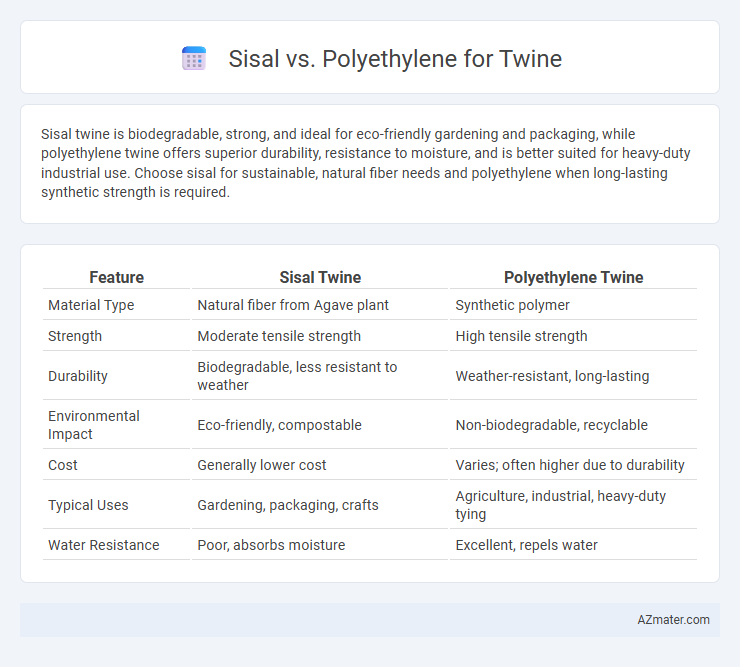Sisal twine is biodegradable, strong, and ideal for eco-friendly gardening and packaging, while polyethylene twine offers superior durability, resistance to moisture, and is better suited for heavy-duty industrial use. Choose sisal for sustainable, natural fiber needs and polyethylene when long-lasting synthetic strength is required.
Table of Comparison
| Feature | Sisal Twine | Polyethylene Twine |
|---|---|---|
| Material Type | Natural fiber from Agave plant | Synthetic polymer |
| Strength | Moderate tensile strength | High tensile strength |
| Durability | Biodegradable, less resistant to weather | Weather-resistant, long-lasting |
| Environmental Impact | Eco-friendly, compostable | Non-biodegradable, recyclable |
| Cost | Generally lower cost | Varies; often higher due to durability |
| Typical Uses | Gardening, packaging, crafts | Agriculture, industrial, heavy-duty tying |
| Water Resistance | Poor, absorbs moisture | Excellent, repels water |
Introduction to Twine Materials
Sisal and polyethylene are two primary materials used in twine production, each offering distinct properties suited to various applications. Sisal, derived from the agave plant, is a natural fiber known for its biodegradability, strength, and resistance to stretching, making it ideal for agricultural and craft uses. Polyethylene twine, a synthetic alternative, provides superior durability, moisture resistance, and tensile strength, commonly favored in industrial and marine environments.
What is Sisal Twine?
Sisal twine is a natural fiber extracted from the leaves of the Agave sisalana plant, known for its strength, durability, and biodegradability, making it ideal for agricultural and gardening uses. Compared to polyethylene twine, sisal offers superior environmental benefits due to its organic origin and ability to decompose without releasing microplastics. Its coarse texture provides excellent grip and knot-holding capability, favored in applications requiring eco-friendly alternatives to synthetic fibers.
What is Polyethylene Twine?
Polyethylene twine is a synthetic fiber made from polymer resin, commonly used in agricultural and industrial applications due to its high tensile strength and resistance to moisture, chemicals, and UV rays. Unlike sisal twine, which is natural and biodegradable, polyethylene twine offers greater durability and longevity, making it ideal for heavy-duty tasks such as baling and packaging. Its lightweight structure combined with chemical and weather resistance ensures consistent performance in outdoor environments.
Strength and Durability Comparison
Sisal twine, derived from natural agave fibers, offers moderate tensile strength and biodegradability but is prone to abrasion and environmental degradation over time. Polyethylene twine, made from synthetic polymers, exhibits superior strength with high resistance to moisture, UV radiation, and wear, providing longer-lasting durability in harsh conditions. For applications requiring sustained load-bearing capacity and weather resilience, polyethylene twine outperforms sisal in both strength retention and lifespan.
Biodegradability and Environmental Impact
Sisal twine, derived from natural fibers of the Agave sisalana plant, offers superior biodegradability compared to polyethylene twine, which is made from non-biodegradable synthetic polymers. The natural decomposition process of sisal reduces long-term environmental pollution, minimizing microplastic accumulation in soil and water ecosystems. Polyethylene twine contributes to persistent plastic waste, posing risks to wildlife and requiring extensive landfill space or incineration.
Cost-Effectiveness and Availability
Sisal twine offers cost-effectiveness through its biodegradability and moderate price, making it a budget-friendly choice for environmentally conscious consumers. Polyethylene twine, while often cheaper upfront and widely available due to mass production, lacks biodegradability but excels in durability and weather resistance. Availability of sisal depends on agricultural production regions, whereas polyethylene twine benefits from global manufacturing networks ensuring consistent supply.
Common Uses for Sisal Twine
Sisal twine is commonly used in gardening, agriculture, and crafting due to its natural fiber properties, making it biodegradable and eco-friendly. It excels in tasks such as tying plants, bundling hay, and creating rustic decorations or macrame projects, where strength and environmental sustainability are essential. Unlike polyethylene twine, sisal offers superior breathability and natural texture, ideal for organic and outdoor applications.
Common Uses for Polyethylene Twine
Polyethylene twine is widely used in agricultural and industrial applications due to its high strength, durability, and resistance to moisture and chemicals. Common uses include bale tying, packaging, and securing cargo, where reliable performance under heavy loads and exposure to outdoor elements is essential. Its synthetic composition makes polyethylene twine ideal for long-term outdoor use, unlike natural fiber twines such as sisal, which degrade more quickly.
Maintenance and Storage Requirements
Sisal twine requires careful storage in a dry environment to prevent moisture absorption that can lead to mold and weakening of fibers, making maintenance critical for longevity. Polyethylene twine offers superior resistance to moisture and UV exposure, demanding minimal maintenance and allowing storage in varied environmental conditions without degradation. Proper storage of sisal twine in well-ventilated, low-humidity areas significantly extends its usability, whereas polyethylene twine's synthetic nature provides enhanced durability with less stringent storage needs.
Choosing the Right Twine for Your Needs
Sisal twine, made from natural fibers, offers superior biodegradability and strength, making it ideal for gardening, agriculture, and eco-friendly packaging. Polyethylene twine, composed of synthetic polymers, provides higher resistance to moisture, UV rays, and abrasion, suitable for heavy-duty applications and prolonged outdoor use. Evaluating the specific requirements of durability, environmental impact, and load-bearing capacity ensures optimal selection between sisal and polyethylene twine.

Infographic: Sisal vs Polyethylene for Twine
 azmater.com
azmater.com